Vestibular System vs
Proprioception
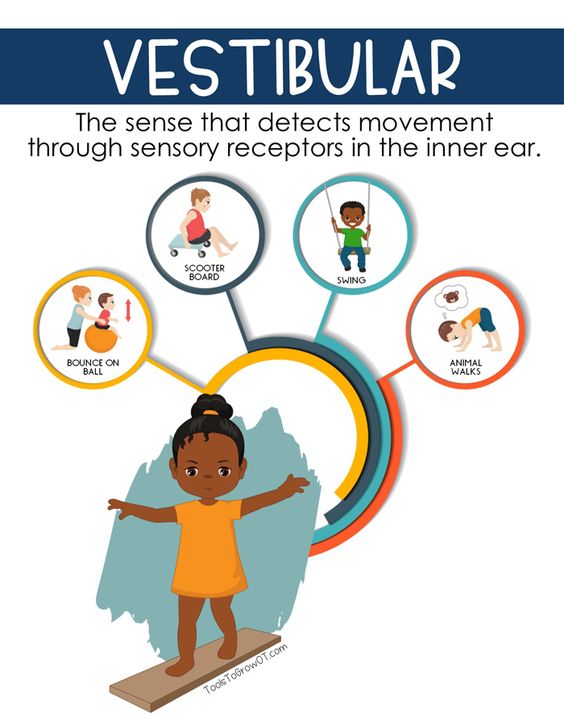 …… . …
…… . … 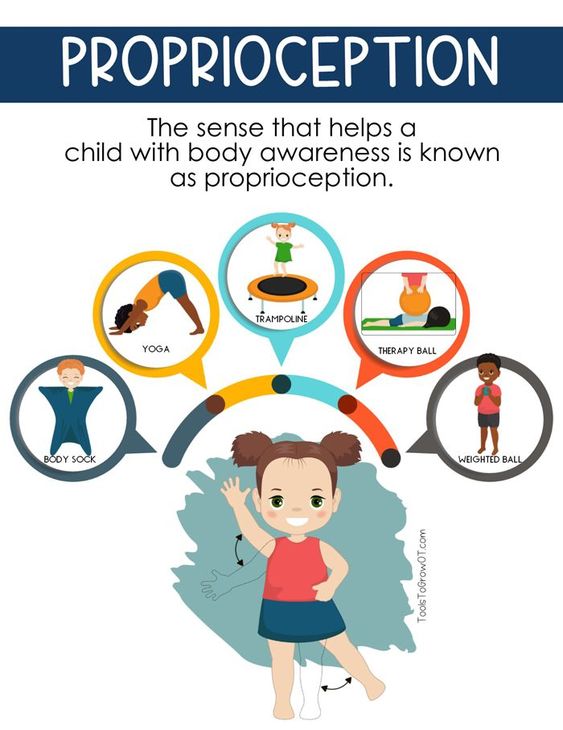
All our senses work together as a team, along with our cognitive skills in order to help us successfully navigate and participate in our world.
The Vestibular System
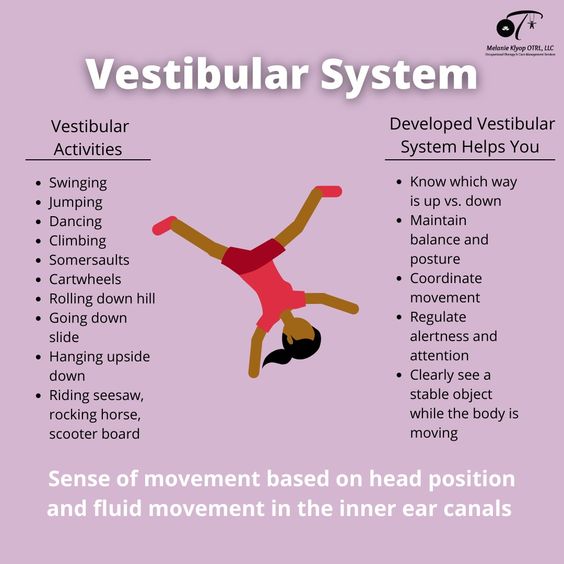
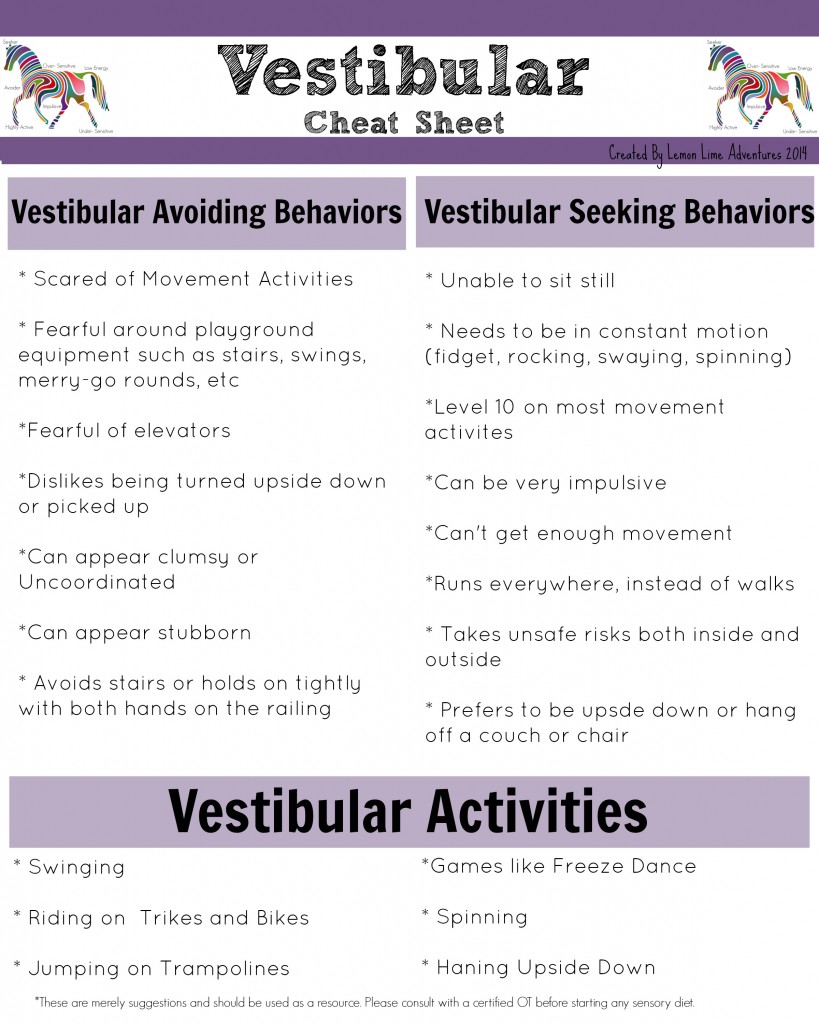
The vestibular system is the first sensory system to fully develop (five months after conception). It is the sensory system considered to have the most important influence on our everyday functioning. The vestibular system is the unifying system that directly influences nearly everything we do. It even impacts how awake and alert we are.
When you think of vestibular, think “movement and balance”. The vestibules (receptors) are located in the inner ear and detect motion. There are 3 canals which are stimulated by changes in head position and detect all different planes of movement. We use our vestibular sense to know which way is up or down, or how fast or slow we move. The vestibular system affects our posture, balance, movement, coordination, attention and arousal. Movement is crucial to development and it also plays a role in the overall self-regulation of our nervous system. Vestibular input is extremely powerful and can be alerting or calming to the nervous system.
The vestibular system has a broad influence in many parts of the brain projecting to:
• The cerebellum (to affect movements of the head, eyes, and posture )
• Cranial nerves III, IV, and VI (to permit the eyes to fix on a moving object while staying in focus )
• Reticular formation (to signal how to adjust circulation and breathing when the body assumes a new position)
• Spinal Cord (to allow quick reflex reactions related to balancing)
• Thalamus (to control head and body motor responses)
Signs of Vestibular Dysfunction
Hypersensitivity to Movement (over-responsive)
• Avoids/dislikes playground equipment, i.e., swings, ladders, slides, or merry-go-rounds
• Prefers sedentary tasks, moves slowly and cautiously, avoids taking risks
• Avoids/dislikes elevators and escalators; may prefer sitting while they are on them or, actually get motion sickness from being in/on them
• May appear terrified of falling even when there is no real risk
• Afraid of heights, even the height of a curb or step
• Fearful of feet leaving the ground
• Fearful of going up or down stairs or walking on uneven surfaces
• Afraid of being tipped upside down, sideways or backwards; will strongly resist getting hair washed over the basin
• Startles if someone else moves them
• As an infant, may never have liked baby swings or jumpers
• May be fearful of, and have difficulty riding a bike, jumping, hopping, or balancing on one foot (especially if eyes are closed)
• May have disliked being placed on stomach as an infant
• Loses balance easily and may appear clumsy
• Fearful of activities which require good balance
• Avoids rapid or rotating movements
Hyposensitivity to Movement (under-responsive)
• In constant motion, cannot seem to sit still
• Craves fast, spinning, and/or intense movement experiences
• Loves being tossed in the air
• Could spin for hours and never appear to be dizzy
• Loves to swing as high as possible and for long periods of time
• Loves the fast, intense, and/or scary rides at amusement parks
• Always jumping on furniture, trampolines, spinning in a swivel chair, or getting into upside down positions
• Is a “thrill-seeker”, dangerous at times
• Always running, jumping, hopping etc., instead of walking
• Rocks body, shakes leg, or head while sitting
• Likes sudden or quick movements, such as, going over a big bump in the car or on a bike
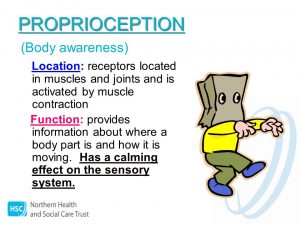
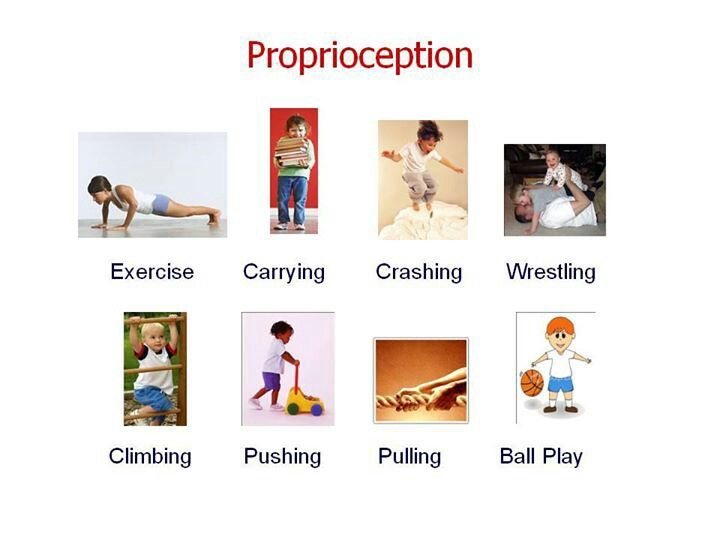 .
. 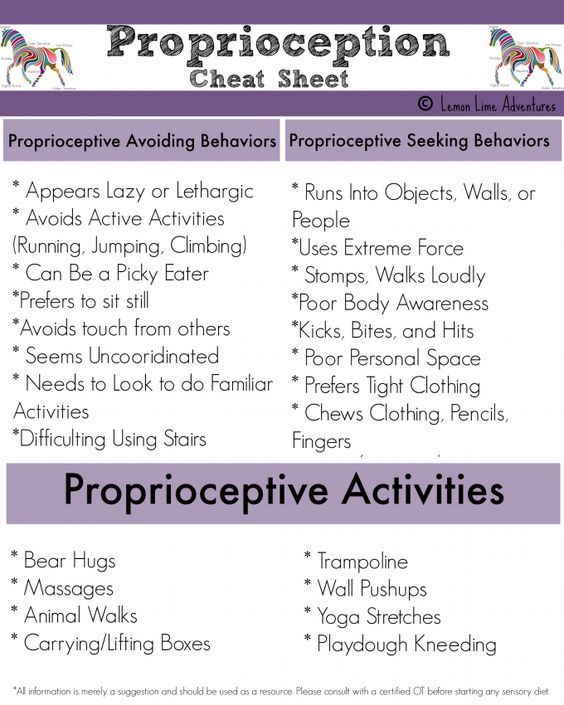
Proprioception can be thought of as the way the body keeps track of and controls the different parts of the body. We use our proprioceptive sense to know where our bodies are in space and how to generate coordinated movements to successfully execute tasks. Proprioceptive receptors, called proprioceptors, are located in the joints, muscles, and tendons all over the body. These receptors are activated by elongation, compression, or traction. i.e. When the muscle bellies are activated, the proprioceptors of the joints are triggered. Weight bearing on joints also triggers the proprioceptive receptors.
Proprioceptive Sensory Seeking Behaviors
• Seeks out jumping, bumping, and crashing activities
• Stomps feet when walking
• Kicks feet on floor or chair while sitting at desk
• Bites or sucks on fingers and/or frequently cracks their knuckles
• Loves to be tightly wrapped in many or weighted blankets, especially at bedtime
• Prefers clothing, including belts, hoods, shoelaces to be as tight as possible
• Loves/seeks out “squishing” activities
• Enjoys bear hugs
• Excessive banging on/with toys and objects
Difficulty Grading of Movement
• Misjudges how much to flex and extend muscles during tasks/activities e.g. putting arms into sleeves
• Difficulty regulating pressure when writing/drawing; may be too light to see or so hard that the tip of the pencil breaks
• Written work is messy, and the child often rips the paper when erasing
• Always seems to be breaking objects and toys
• Misjudges the weight of an object, such as a glass of juice, picking it up with too much force and sending it flying or spilling, or with too little force and complaining about objects being too heavy
• May not understand the idea of “heavy” or “light”; would not be able to hold two objects and tell you which weighs more
• Seems to do everything with too much force, i.e., walking, slamming doors, slamming objects down
• Plays with animals with too much force, often unintentionally hurting them
• Plays too roughly with other children
Functions of the vestibular system and proprioception system overlap as the proprioceptive receptors also respond to movement and gravity.
This is an example which simply illustrates how the 2 systems overlap:
Our vestibular sensory system tells us if our head or our body is moving. If we begin to walk across a room, our vestibular system tells our brain that our head is moving through space. Our proprioceptors from our legs also send messages to our brain, to tell our brain that our legs are moving, thus our brain “concludes” that our whole body is in motion. If we just turn our head because we hear our name being called, our vestibular system tells our brain that our head is in motion, but since our brain is not getting information from our legs, our brain “concludes” that only our head, and not our whole body is in motion. If we watch someone else moving across the room, our vestibular system tells our brain that we aren’t moving, that we are still.
Summary
Vestibular is “movement” and Proprioception is “heavy work”.
|
|
VESTIBULAR SYSTEM | PROPRIOCEPTION |
| Receptors | Receptors in the inner ear – semicircular canals and otoliths
|
Receptors located in muscles, joints, tendons, ligaments, and connective tissue |
| Activation | Any time we move our head, but the vestibular system also continuously being activated by the downward force of gravity to give us a sense of where we are in space | Activated any time we push or pull on objects (such as closing or opening a car door), when the joints are compressed together or stretched apart (such as jumping up and down or hanging on monkey bars). |
| Role | Vestibular information travels to many structures in the brain that serve a number of critical functions such as: arousal regulation, static and dynamic postural control, balance and equilibrium responses, bilateral coordination, maintenance of a stable visual field, and spatial perception for efficient navigation of the body through space. The vestibular system tells us if we are moving or not, and how fast we are moving. It also tells us in which direction we are moving; if we are upright, upside down, or at a tilt. It tells us whether objects are still or moving in relation to our body. |
Unconscious awareness of body position.
The proprioceptive system provides information about the position, force, direction and movement of our own body parts. It helps us know how much force we are using and whether we need to use more or less force in order to successfully complete the task. Even when we aren’t moving our proprioceptive system is responding to gravity. E.g.When we close our eyes, we know where our feet, arms, and hands are, because our proprioceptive system is the internal sense that gives us this information. |
| Impact | Can produce a variety of responses. It can be calming, organizing, alerting, or disorganizing depending on the type of movement and the sensitivity of the individual | Proprioceptive input tends to have a calming and organizing effect on the body, particularly when feeling overstimulated or overwhelmed |
OT Intervention
Sensation is food to the nervous system. Providing children who have challenges processing and integrating proprioceptive and vestibular sensory input throughout the course of their day, will help feed their nervous systems what they need.
Resources:
https://www.spdstar.org/basic/your-8-senses
https://spdaustralia.com.au/the-vestibular-system/
https://blog.ochsner.org/articles/vestibular-system-and-proprioception-the-two-unknown-senses
https://www.elitecme.com/resource-center/rehabilitation-therapy/internal-senses-understanding-the-sensory-system-beyond-the-basics/